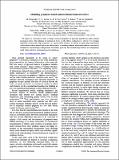Por favor, use este identificador para citar o enlazar a este item:
http://hdl.handle.net/10261/44583COMPARTIR / EXPORTAR:
 SHARE SHARE
 CORE
BASE CORE
BASE
|
|
| Visualizar otros formatos: MARC | Dublin Core | RDF | ORE | MODS | METS | DIDL | DATACITE | |

| Campo DC | Valor | Lengua/Idioma |
|---|---|---|
| dc.contributor.author | Roche, Stephan | - |
| dc.contributor.author | Cuniberti, Gianaurelio | - |
| dc.date.accessioned | 2012-01-23T12:00:52Z | - |
| dc.date.available | 2012-01-23T12:00:52Z | - |
| dc.date.issued | 2010 | - |
| dc.identifier.citation | Physical Review B 81(19): 193404 (2010) | es_ES |
| dc.identifier.issn | 1098-0121 | - |
| dc.identifier.uri | http://hdl.handle.net/10261/44583 | - |
| dc.description | 4 páginas, 3 figuras.-- PACS number(s): 72.80.Vp, 73.22.Pr, 71.30.+h.-- et al. | es_ES |
| dc.description.abstract | We report on a theoretical study of charge transport properties of graphene nanoribbons under external mechanical stress. The influence of mechanical forces on the ribbon conductance is shown to be strongly dependent on the ribbon edge symmetry, i.e., zigzag versus armchair. In contrast to zigzag-edge nanoribbons which remain robust against high strain deformations, a stretching-induced metal-semiconductor transition is obtained for armchair-edge configurations. Our results point out that armchair edge ribbons are consequently much better suited for electromechanical applications. | es_ES |
| dc.description.sponsorship | This work was partially funded by Alexander von Humboldt Foundation, by the WCU (World Class University) program through the Korea Science and Engineering Foundation sponsored by the Ministry of Education, Science and Technology (Project No. R31-2008-000-10100-0), the European Social Funds in Saxony, and the cluster of excellence “ECEMP—European Centre for Emerging Materials and Processes Dresden.” S.R. acknowledges the ANR/P3N2009 (project NANOSIM_GRAPHENE Project No. ANR-09-NANO-016- 01) and the grant by the Friedrich Willhelm Bessel foundation. | es_ES |
| dc.language.iso | eng | es_ES |
| dc.publisher | American Physical Society | es_ES |
| dc.rights | openAccess | es_ES |
| dc.title | Modeling graphene-based nanoelectromechanical devices | es_ES |
| dc.type | artículo | es_ES |
| dc.identifier.doi | 10.1103/PhysRevB.81.193404 | - |
| dc.description.peerreviewed | Peer reviewed | es_ES |
| dc.relation.publisherversion | http://dx.doi.org/10.1103/PhysRevB.81.193404 | es_ES |
| dc.identifier.e-issn | 1550-235X | - |
| dc.contributor.funder | Alexander von Humboldt Foundation | - |
| dc.contributor.funder | Korea Science and Engineering Foundation | - |
| dc.contributor.funder | European Commission | - |
| dc.contributor.funder | European Centre for Emerging Materials and Processes Dresden | - |
| dc.identifier.funder | http://dx.doi.org/10.13039/100005156 | es_ES |
| dc.identifier.funder | http://dx.doi.org/10.13039/501100004084 | es_ES |
| dc.identifier.funder | http://dx.doi.org/10.13039/501100000780 | es_ES |
| dc.type.coar | http://purl.org/coar/resource_type/c_6501 | es_ES |
| item.languageiso639-1 | en | - |
| item.fulltext | With Fulltext | - |
| item.openairecristype | http://purl.org/coar/resource_type/c_18cf | - |
| item.cerifentitytype | Publications | - |
| item.grantfulltext | open | - |
| item.openairetype | artículo | - |
| Aparece en las colecciones: | (CIN2) Artículos | |
Ficheros en este ítem:
| Fichero | Descripción | Tamaño | Formato | |
|---|---|---|---|---|
| e193404.pdf | 338,73 kB | Adobe PDF |  Visualizar/Abrir |
CORE Recommender
SCOPUSTM
Citations
59
checked on 01-abr-2024
WEB OF SCIENCETM
Citations
53
checked on 24-feb-2024
Page view(s)
271
checked on 23-abr-2024
Download(s)
377
checked on 23-abr-2024
Google ScholarTM
Check
Altmetric
Altmetric
NOTA: Los ítems de Digital.CSIC están protegidos por copyright, con todos los derechos reservados, a menos que se indique lo contrario.
